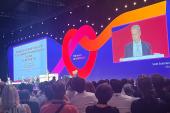Dapagliflozin’s Benefits Similar in HF Patients With Improved EF: DELIVER
The new data may help hone patient care, while fueling debate around disparate DELIVER and EMPEROR-Preserved results.

Among patients with heart failure (HF), those who once had an ejection fraction in the reduced range but now have one above 40% derive benefits from dapagliflozin (Farxiga; AstraZeneca) similar to what’s seen in patients who have always had preserved ejection fraction, according to a subanalysis of the DELIVER trial.
In the group with HF with improved ejection fraction (HFimpEF), which accounted for 18% of the trial population, treatment with the sodium-glucose cotransporter 2 (SGLT2) inhibitor provided a 26% reduction in the risk of cardiovascular death or worsening HF relative to placebo. That’s comparable to the 18% relative risk reduction seen in the overall trial and the 16% reduction observed among the patients with an EF consistently above 40%.
Orly Vardeny, PharmD (University of Minnesota and Minneapolis VA Health Care System, MN), reported the results, which are set to be published in Nature Medicine, on Sunday at the Heart Failure Society of America (HFSA) 2022 meeting in Washington, DC.
The findings suggest, she said, that patients with HFimpEF “who remain symptomatic may benefit from the addition of an SGLT2 inhibitor to previously instituted GDMT [guideline-directed medical therapy] to further reduce morbidity and mortality.”
The HF category is a relatively new one, formally defined for the first time in the latest update to the American College of Cardiology/American Heart Association/HFSA guidelines released earlier this year. Patients with HFimpEF have typically been excluded from other trials of therapies for HF with reduced ejection fraction (HFrEF) and HF with preserved ejection fraction (HFpEF), Vardeny said. In the latter category, EMPEROR-Preserved showed significant benefits empagliflozin (Jardiance; Boehringer Ingelheim/Eli Lilly) in the overall cohort, but with some attenuation at higher ejection fractions.
The current study, Vardeny noted, is the largest to date with randomized data in HFimpEF patients.
A Growing Population
Because of advances in treatment of HFrEF, the number of patients with HFimpEF, which historically has been defined in various ways, is rising. The latest guidelines recommend keeping patients with HFimpEF on GDMT to avoid backsliding into HFrEF territory.
But whether the addition of medications like SGLT2 inhibitors could further improve outcomes in patients with already improved LVEF was unclear, and the inclusion of these types of patients in DELIVER provided the opportunity to explore the question.
Trial investigators randomized 6,263 patients with an LVEF over 40%, evidence of structural heart disease, and elevated natriuretic peptides to dapagliflozin 10 mg once daily or placebo on top of usual therapy and followed them for a median of 2.3 years. Dapagliflozin reduced the rate of CV death or worsening heart failure, the primary endpoint (16.4% vs 19.5%; HR 0.82; 95% CI 0.73-0.92).
For the current analysis, Vardeny and colleagues focused on the 1,151 patients (mean age 70.1 years; 67.2% men) who were included in the trial after having their LVEF improve from 40% or lower to above that cutoff on GDMT. Compared with patients who had an EF consistently above 40%, the HFimpEF group was younger, more likely to be male and to have NYHA class II symptoms, and less likely to be white. They had a lower baseline EF (mean 50.5% vs 55.0%), and were receiving treatments consistent with an HFrEF population, being more likely to have an implantable cardioverter-defibrillator and to be taking angiotensin receptor-neprilysin inhibitors, beta-blockers, and mineralocorticoid receptor antagonists.
Despite these differences, patients with HFimpEF had rates of adverse clinical outcomes during follow-up that were similar to those seen in the rest of the participants. And, as in the overall trial, dapagliflozin reduced the composite of CV death or worsening HF in this group (16% vs 21%; HR 0.74; 95% CI 0.56-0.97), with a number needed to treat of 20.
There were no significant differences in treatment effects between the HFimpEF group and the rest of the participants in terms of the primary endpoint, its components, or any other clinical outcomes (P = NS for all interactions). Of note, however, the risk of CV death was lower with dapagliflozin in the HFimpEF group (HR 0.62; 95% CI 0.56-0.97), but not in those who consistently had an EF above 40% (HR 0.95; 95% CI 0.78-1.15). Vardeny cautioned that that finding should be considered hypothesis-generating due to small numbers.
HFimpEF status did not significantly modify the improvements seen in total symptom scores on the Kansas City Cardiomyopathy Questionnaire with dapagliflozin, or affect safety of the treatment.
More Like HFrEF Than HFpEF?
Commenting on this latest analysis for TCTMD, John Cleland, MD (University of Glasgow, Scotland), said it was “quite striking” to see a lower rate of CV death with dapagliflozin in the HFimpEF group, but no similar signal in the rest of the trial cohort. That may help to explain why EMPEROR-Preserved, with no HFimpEF patients, showed no differences in CV death between trial arms.
As such, any suggestion that there is an overall reduction in CV death across the range of LVEF, supported by presentations at the European Society of Cardiology Congress 2022 as well as another presentation at the HFSA meeting combining data from DAPA-HF and DELIVER, should be tempered by the findings from Vardeny and colleagues, Cleland said.
“It should make us hesitate a little bit to say that the SGLT2 inhibitors are reducing cardiovascular death across the board of left ventricular ejection fraction, when it’s really being driven by these people in the HFpEF group who were previously HFrEF,” he said.
One might imagine that the pathophysiology underlying heart failure in patients who have seen their LVEF rise from below to above 40% would be more similar to HFrEF than HFpEF, Cleland said, and that has implications for treatment. The HFimpEF group should probably be treated as if they have HFrEF, he added, noting that the TRED-HF trial demonstrated the harm that can come from backing off on GDMT in patients who have responded to treatment.
“The underlying pathology is still there, and therefore there is a rationale that these patients with heart failure and improved ejection fraction should be treated as though they are HFrEF even though their ejection fraction has recovered,” Cleland said. Device therapies like implantable cardioverter-defibrillators and cardiac resynchronization therapy are exceptions, he suggested, as there wouldn’t be a strong rationale to use them in patients who have had gains in LVEF.
HFimpEF “should really be considered as recovered HFrEF rather than HFpEF, [which] means that the benefit in the HFpEF population [who] haven’t had this improved ejection fraction will be less than the headline results of the overall study,” Cleland commented.
“And those more-modest benefits might make you hesitate [using SGLT2 inhibitors] for a patient who is, with solid HFpEF, doing well, not with grossly elevated natriuretic peptides, and symptomatically feeling not too bad,” he continued. “Is it really worthwhile then taking another medication? If healthcare resources are unlimited, then perhaps you would want to treat them as well, but if we have to choose who we should treat, then the benefits are going to be greater for this [HFimpEF] group compared to those patients who are and always have been HFpEF.”
Todd Neale is the Associate News Editor for TCTMD and a Senior Medical Journalist. He got his start in journalism at …
Read Full BioSources
Vardeny O. Dapagliflozin in heart failure with improved ejection fraction: the DELIVER trial. Presented at: HFSA 2022. October 2, 2022. Washington, DC.
Disclosures
- The DELIVER trial was funded by AstraZeneca.
- Vardeny reports having received research support from AstraZeneca, Bayer, and Cardurion.
- Cleland reports no relevant conflicts of interest.





Comments